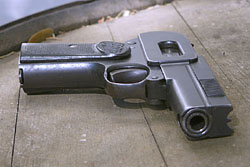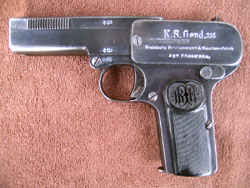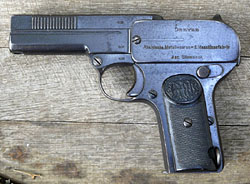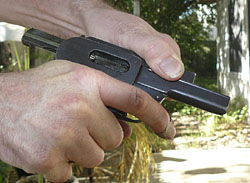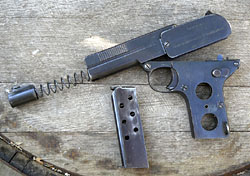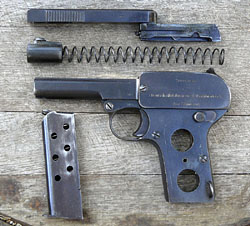 |
||||||||||||||||||||||||||||||||||||||||||||||||||||||||||||||||||||||||||||||||||||||||||||||||||||||||||||||||||||||||||||||||||||||||||||||||||||||||||||||||||||||||||||||||||||||||||||||||||||||||||||||||||||||||||||
|
The 1907 Dreyse Pistol by Ed Buffaloe
The 1907 Dreyse pistol was patented on 21 February 1908 by Rheinische Metallwaaren- & Machinenfabrik. The gun has long been attributed to Louis Schmeisser, though his name does not appear on the patent. The patent does not show the hinged upper receiver and barrel--what was actually patented was the design of the breech block/slide and the front bushing. However, another patent by RM&M, German patent 185411, dated 4 January 1906, shows a gun with a barrel that can be hinged upward, which looks very much like a Bergmann Simplex, a gun also attributed to Louis Schmeisser. The 1907 Dreyse is a striker-fired unlocked-breech design chambered for the 7.65mm Browning cartridge (.32 ACP). It was strongly influenced by the 1900 Browning, though the Browning has its recoil spring above the barrel, while the Dreyse has a concentric recoil spring. Nonetheless, the overall shape is similar, as are the grip angle, the magazine release, and the positioning of the manual safety. The magazines are interchangeable. Both guns have breech blocks that protrude from the rear of the gun during recoil. The only advantage of Schmeisser’s design is that it can be disassembled somewhat more easily than the Browning. It does not require a screwdriver to remove screws from the breech block, like the Browning, though it does require some sort of tool to depress the recoil spring bushing. The 1907 Dreyse does not have a full-length slide like the Browning. The slide extends about three-quarters of the way down the top of the gun, and the breech block depends from it. The slide and breech block reciprocate in the upper receiver housing. Because the rear portion of the upper receiver housing is fixed and does not reciprocate, the slide must be grasped at the front in order to chamber a round--the forward portion of the slide has serrations for this purpose. The barrel is fixed in the upper receiver housing, and sits beneath the slide. The recoil spring is held in place around the barrel by a collar-like bushing at the front of the housing. A T-shaped extension on top of the bushing fits into a recess in the bottom of the slide, so that the bushing compresses the recoil spring as the slide moves to the rear (early pistols had a hook on the slide rather than on the bushing). The entire upper housing is hinged so that it can be rotated upward to allow removal of the slide/breech block. A button on the rear of the grip tang moves to the right to allow the upper housing to pivot, but the button is prevented from moving if the striker is cocked. The breech block contains the striker, the extractor, and the cocking indicator. The cocking indicator protrudes from the back of the breech block when the striker is cocked The extractor is a flat piece of spring steel with a hook on the end, and is very similar in design to that of the 1900 Browning. Ejection is to the right through an ejection port in the right side of the upper receiver housing. The ejector is fitted into the left side of the upper receiver housing and held in place by a screw. This same screw also retains the barrel in the housing--with the screw removed, the barrel can be unscrewed using a special tool.
Hogg states that early guns had a sear which simply released the striker, but that wartime production guns had a modified sear that forced the striker back a little further before releasing it. This was apparently necessary because some of the military ammunition had very hard primers. The shape of the sear was modified slightly numerous times during the course of production, and I now have seen evidence of a second variant pistol with a relatively late serial number in which the striker does appear to move backward before being released. At this time, I do not have an estimate of exactly when this feature was added to the gun. If your gun has this feature, please send me the serial number. The serial number is stamped on the top of the breech block (except on a few early guns), just behind the slide, and also on the frame just in front of the magazine well. The highest serial number I have recorded thus far is 250283a. I have seen a statement that there is a Model 1907 Dreyse with the serial number 254857 but have been unable to verify this myself. It is generally believed that the serial number range of the Rheinmetall pistol which was patented in 1920 began at about 251000, but it is possible that 1907 parts were still being assembled into pistols in the same time period. Full production probably did not begin until 1908. According to E. Brunnth in his article in the February 1971 Deutches Waffenjournal, production ended at the end of World War I. German police are known to have used the 1907 Dreyse well into the 1930’s. The grips are of checkered horn with an oval cartouche at the top containing the RM&M monogram. Early grips had the retention screw at the rear edge of the grip plate, but it was later moved to the center of the grip where it remained for the vast majority of the guns produced. There are two major variants of the gun, with a number of minor variations within the two, particularly in early production. I will attempt to summarize the variations briefly, in a chart, then provide more detailed descriptions below.
Early First Variant
The early first variant Dreyse has several minor differences from later guns. The grip plates are made of checkered horn with an oval cartouche at the top containing the RM&M monogram, and are fitted into dovetails in the grip frame, held in place by a single screw on either side centered at the back edge of the grip. The left side grip screw also serves to retain the side plate that allows access to the lockwork. The second screw securing the side plate, located just behind the trigger, extends all the way through the right side of the frame. There is no lanyard ring. The manual safety lever on a few guns has concentric grooves on the circular portion which is grasped by the t
The Dreyse is listed in both the 1910 Deutsche Waffenfabrik Georg Knaak catalogue and the ALFA catalogue of 1911. The drawings show a gun with the grip screw at the rear of the grip frame and a three line inscription like that of the later guns except the first line reads “DREYSE 1907.” The ALFA catalogue also shows a Polizeimodell, or police model, with no groove below the slide and the slide serrations extending down over the lower receiver housing. Don Maus, in his book History Writ in Steel, states that the first 700 or so Model 1907 Dreyse pistols were made for and sold to the Sächsische Gendarmerie (Saxony Police), and they clearly differ from what we now know as the standard production model. The police model has a flat-topped slide and a much higher rear sight than the standard guns. The “DREYSE” marking is omitted and in its place is “K. S. Gend.”, followed by the serial number. One of these guns is described in Matthews’ book Firearms Identification, Volume I. I had suspected that Rheinmetall quickly concluded it would be more economical to make a single version of the gun and dropped the police model, so the first 700 or so guns were the only ones ever made. However, the succeeding guns, up to approximately serial number 6000 look like the drawing in the ALFA catalogue of the Polizeimodell, with a scalloped slide and the slide serrations extending over the lower receiver housing. I have now documented a flat-topped 1907 Dreyse with a serial number as high as 55858. We know that the 1907 Dreyse had no disconnector or lanyard ring through at least serial number 8047 and that by serial number 9305 it had both. I have documented only a few guns, all with four -digit serial numbers, that have concentric rings on the safety (6009, 6934, 7420, 8047). If you have a gun in or near this serial number range, I would very much like to know whether or not your gun has a disconnector and/or a lanyard ring and/or a safety with concentric rings instead of checkering.* Tillig states that the narrow extractor continued to be used up to serial number 15000 , though serial number 18825 appears to still have it, so I would suggest it may have been in use even later. The grips with the screw at the rear continued to be used at least through serial number 32957, and possibly later. Some guns were made with a screw in the center of the left grip as well as at the rear (between 23326 to 32014). I assume that eventually the company decided it would be cheaper and easier to move the rear screw to beneath the grip plate. According to Tillig, after the first 700 pistols, and up to approximately serial number 6000, the Dreyse Pistols were marked as follows: DREYSE 1907 Rheinische Metallwaaren- & Maschinenfabrik A few scarce pistols have a retailer marking instead of the company name and address. I would have liked to define an early first variant as any gun with no disconnector, but there were several other differences between the early and late guns that I couldn’t ignore. A number of minor changes were made in the early gun, as it transitioned to what I call the late first variant, including the addition of a lanyard ring, the redesign of the front bushing and elimination of the hook on the front of the slide, the shortening of the forward sideplate screw, and the widening of the extractor. At this time I can’t say exactly when these changes were made, though some may have coincided with the addition of the disconnector. I’m still collecting information on these transitional guns. Late First Variant
All the late first variant Dreyse pistols have a disconnector. A depression was also milled in the bottom of the breech block to accept the upper lobe of the disconnector. When the slide is out of battery the disconnector is depressed and the connector bar is lifted out of contact with the sear. The dovetailing of the grip frame and grips was eliminated in the late first variant, reducing manufacturing time. The side plate screw behind the trigger does not extend all the way through the frame on the other side. There is a fixed U-shaped lanyard ring on the left side of the grip at the bottom rear. The manual safety lever is checkered and lies flush with the side of the receiver. The steel spring extractor is approximately 3mm wide. The gun is marked on the left side of the upper receiver as follows: DREYSE Rheinische Metallwaaren- & Maschinenfabrik These guns were marketed worldwide and are therefore sometimes found stamped for export: GERMANY. Second Variant The contour of the upper receiver housing on the second variant is altered so that it rises to a point at the upper rear where the housing forms the rear sight. Most second variant guns have slanted triangular-cut serrations at the front of the slide--these are not raised ridges, as on the First Variant, but are actual cuts. This change simplified the machining of the slide. Soon after the introduction of the second variant frame, the safety lever was redesigned to have an offset for the checkered portion. I don’t know exactly when these changes were made, so I would like to hear from owners of first variant guns with high serial numbers or owners of second variant guns with low serial numbers--please include a description or preferably photographs of your gun.* (The highest first variant serial number I have recorded is 215661, while the lowest second variant serial number I have recorded is 216158.) Some second variant guns were marked as above but, after the company began using the name Rheinmetall, they were marked on the left side of the upper receiver as follows: DREYSE RHEINMETALL ABT. SÖMMERDA Soon after the change in the slide legend, the takedown cutout beneath the front of the barrel was eliminated. Serial number 229962 still has the old slide legend and the cutout, but 234028 has neither. During this period of production, I have discovered some earlier guns with the new features and some later guns with the old features. For instance, serial number 226030 has the new features, whereas 249855 has vertical ridges at the front of the slide and the old slide legend, but no slide cutout. If anyone has a gun with the new slide legend that still has the cutout beneath the barrel, I would appreciate hearing from you.* The last few thousand guns produced returned to having raised ridges at the front of the slide, but they were angled and in a square block. A few late guns have no manufacturer markings. Some are stamped for export on the left side of the slide just behind the serrations MADE IN GERMANY or GERMANY in all capital sans-serif characters. I would be interested to receive serial number information, descriptions, and photographs from readers in order to determine at what point various changes were made to the gun*
Evaluation The Dreyse is a rather awkward pistol. It’s grip angle isn’t quite right, and it seems top-heavy. The weight of the slide lies above the barrel. Nonetheless, the 1907 Dreyse was reasonably successful, considering that nearly a quarter- million were made. It was purchased by the Saxon state police and the Berlin municipal police, and saw considerable use during the First World War. A few thousand were purchased by the Czech military in 1921 and 1922, but they were removed from service in 1923 due to unspecified accidents with them. Knowledgable gun writers state that the 1907 Dreyse, when properly maintained, is a reliable pistol, but my gun does not function reliably. The gun fires and ejects the spent cartridge with no problem. But the striker does not always stay locked securely behind the sear. I think this is due to the design of the sear which forces the striker back slightly before releasing it-- both surfaces where striker and sear meet are slightly curved, and the sear spring is not strong enough to keep it locked behind the striker. The striker rides back over the sear before the next round is chambered and the slide is back in battery. I replaced the worn sear, but that did not resolve the problem. I may need a new sear spring. * Write to me at edbuffaloe@unblinkingeye.com
|
||||||||||||||||||||||||||||||||||||||||||||||||||||||||||||||||||||||||||||||||||||||||||||||||||||||||||||||||||||||||||||||||||||||||||||||||||||||||||||||||||||||||||||||||||||||||||||||||||||||||||||||||||||||||||||
|
||||||||||||||||||||||||||||||||||||||||||||||||||||||||||||||||||||||||||||||||||||||||||||||||||||||||||||||||||||||||||||||||||||||||||||||||||||||||||||||||||||||||||||||||||||||||||||||||||||||||||||||||||||||||||||
|
Copyright 2008-2012 by Ed Buffaloe. All rights reserved. |
||||||||||||||||||||||||||||||||||||||||||||||||||||||||||||||||||||||||||||||||||||||||||||||||||||||||||||||||||||||||||||||||||||||||||||||||||||||||||||||||||||||||||||||||||||||||||||||||||||||||||||||||||||||||||||
|
|
||||||||||||||||||||||||||||||||||||||||||||||||||||||||||||||||||||||||||||||||||||||||||||||||||||||||||||||||||||||||||||||||||||||||||||||||||||||||||||||||||||||||||||||||||||||||||||||||||||||||||||||||||||||||||||

